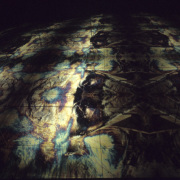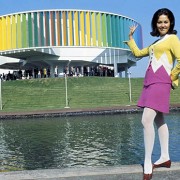Sponsored by six Canadian chemical companies and conceived with the theme of “colour,” Kaleidoscope was created by the University of Waterloo’s Institute of Design and the Toronto industrial design firm of Morley Markson and Associates. The pavilion exterior was designed as a cylindrical carousel of 112 vertical fins making up a three-dimensional colour wheel. In the interior, Markson created a psychedelic, abstract sound-and-image play over mirrored surfaces, using sculpted light, film, and slide projections. As Donald Theall has described it, four chambers protruded from a central core (housing the projection room). One chamber at the top of a ramp served as audience entrance and exit; viewers then moved through three different-shaped theatres that projected the three-part, twelve-minute film Man and Colour, transitioning from figurative images to pure, abstract colour. In Theatre 1, reflections created a limitless horizon through mirrors on the left, right, and end walls. The projected images of nature included twinkling stars, water and waves, a girl running through an orchard, flowers, birds, and balloonaIn the diamond-shaped Theatre 2, mirrors on the floor, ceiling, and rear wall (through which the image was projected) created an infinity effect in depth and height, a seeming tower of light. The images transitioned to a “world of technology,” where industrial scenes included molten metal with sparks, flashing red, blue, and green squares, and amplified prism-like grids of colour. In the cube-like Theatre 3, mirrors on all surfaces (except where the projection originated from) produced an infinity effect in all directions. From this “world of the fantastic,” as Markson described it, spectators moved toward a huge sphere extending above and below them. The three screens in the chambers were twelve feet by eighteen feet by nineteen feet, the closest distance of viewers to the screens being twelve feet and the furthest distance thirty-two feet. Theatre capacity was fifty people in each chamber every five minutes, with 7,200 people moving through the spaces in a day. Collaborating with Canadian composer R. Murray Schafer, the pavilion’s designers created emotional, physical, and psychological explorations of colour through mirrored multiplication and amplification into “kaleidoscopic, cosmic super-realities.” (Monika Kin Gagnon)
Morley Markson
Morley Markson is a Toronto-based filmmaker, photographer, industrial and exhibition designer. In addition to the experimental multi-media design of Kaleidoscope at Expo 67, including the films, he has designed numerous experiential environments. As filmmaker, he made Breathing Together: Revolution of the Electric Family (1971) on the suppression of radical activists in the US, and The Life and Times of Allen Ginsberg (1993), as well as other films beginning in the 1970s.







